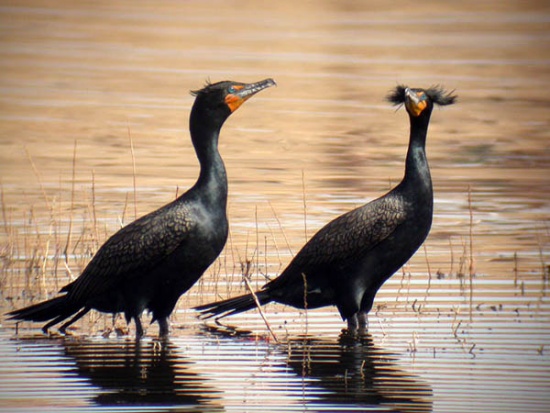Nomdeploom (talk | contribs) (add and edit information.) |
Nomdeploom (talk | contribs) |
||
| Line 4: | Line 4: | ||
==Identification== | ==Identification== | ||
L. 74–91 cm (29–36 in)<br/> | L. 74–91 cm (29–36 in)<br/> | ||
| − | W. up to 132 cm (52 in) | + | W. up to 132 cm (52 in)<br> |
| − | '''Adults''': This is a large, black bird that may have green sheen in some lighting. It has a long tail, a chin patch of bare orange skin, and white double head plumes for a short period during breeding. Eastern birds are duller. | + | '''Adults''': This is a large, black bird that may have green sheen in some lighting. It has a long tail, a chin patch of bare orange skin, and white double head plumes for a short period during breeding. Eastern birds are duller.<br> |
| − | '''Juveniles''': Variable plumage; overall dark brown, with paler face, foreneck, and breast. | + | '''Juveniles''': Variable plumage; overall dark brown, with paler face, foreneck, and breast.<br> |
In flight, note crooked neck. Flies in wavy, loose flocks. | In flight, note crooked neck. Flies in wavy, loose flocks. | ||
Revision as of 16:01, 5 March 2009
- Phalacrocorax auritus
Identification
L. 74–91 cm (29–36 in)
W. up to 132 cm (52 in)
Adults: This is a large, black bird that may have green sheen in some lighting. It has a long tail, a chin patch of bare orange skin, and white double head plumes for a short period during breeding. Eastern birds are duller.
Juveniles: Variable plumage; overall dark brown, with paler face, foreneck, and breast.
In flight, note crooked neck. Flies in wavy, loose flocks.
Similar Species
The Brandt's Cormorant lacks the orange chin, and has a shorter tail. The Neotropic Cormorant only rarely appears as far north as the southern tip of Texas; it is a bird of southern latitudes.
Distribution
A very common and widespread species, it winters anywhere that is ice-free along both coasts of North America, as far north as southern Alaska (on the west coast) and southern New England (on the east coast). It can be found as far south as Mexico and the Bahamas. It migrates from the coldest parts of its breeding range, such as eastern Canada, and has occurred in Europe as a very rare vagrant, for example in Great Britain, Ireland and the Azores.
Taxonomy
Habitat
Oceans and fresh water ponds and lakes. This is the only cormorant in the US that is commonly found on fresh water.
Behaviour
The Double-crested Cormorant swims low in the water, often with just its neck and head visible, and dives from the surface. It uses its feet for propulsion and is able to dive to a depth of 1.5–7.5 m (5–25 feet) for 30–70 seconds. After diving, it spends long periods standing with its wings outstretched to allow them to dry, since they are not fully waterproofed. This species flies low over the water, with its bill tilted slightly upward, sometimes leaving the colony in long, single-file lines.




